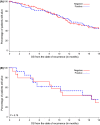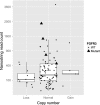FGFR3 expression in primary and metastatic urothelial carcinoma of the bladder
- PMID: 24846059
- PMCID: PMC4303151
- DOI: 10.1002/cam4.262
FGFR3 expression in primary and metastatic urothelial carcinoma of the bladder
Abstract
While fibroblast growth factor receptor 3 (FGFR3) is frequently mutated or overexpressed in nonmuscle-invasive urothelial carcinoma (UC), the prevalence of FGFR3 protein expression and mutation remains unknown in muscle-invasive disease. FGFR3 protein and mRNA expression, mutational status, and copy number variation were retrospectively analyzed in 231 patients with formalin-fixed paraffin-embedded primary UCs, 33 metastases, and 14 paired primary and metastatic tumors using the following methods: immunohistochemistry, NanoString nCounterTM, OncoMap or Affymetrix OncoScanTM array, and Gain and Loss of Analysis of DNA and Genomic Identification of Significant Targets in Cancer software. FGFR3 immunohistochemistry staining was present in 29% of primary UCs and 49% of metastases and did not impact overall survival (P = 0.89, primary tumors; P = 0.78, metastases). FGFR3 mutations were observed in 2% of primary tumors and 9% of metastases. Mutant tumors expressed higher levels of FGFR3 mRNA than wild-type tumors (P < 0.001). FGFR3 copy number gain and loss were rare events in primary and metastatic tumors (0.8% each; 3.0% and 12.3%, respectively). FGFR3 immunohistochemistry staining is present in one third of primary muscle-invasive UCs and half of metastases, while FGFR3 mutations and copy number changes are relatively uncommon.
Keywords: Biomarker; FGFR3; bladder cancer; metastatic urothelial carcinoma; muscle-invasive urothelial carcinoma; targeted therapy.
© 2014 The Authors. Cancer Medicine published by John Wiley & Sons Ltd.
Figures




References
-
- Barbisan F, Santinelli A, Mazzucchelli R, Lopez-Beltran A, Cheng L, Scarpelli M, et al. Strong immunohistochemical expression of fibroblast growth factor receptor 3, superficial staining pattern of cytokeratin 20, and low proliferative activity define those papillary urothelial neoplasms of low malignant potential that do not recur. Cancer. 2008;112:636–644. - PubMed
Publication types
MeSH terms
Substances
LinkOut - more resources
Full Text Sources
Other Literature Sources
Medical

